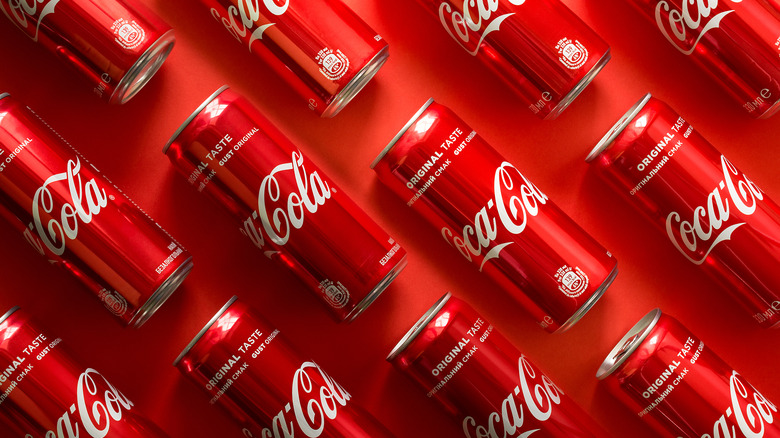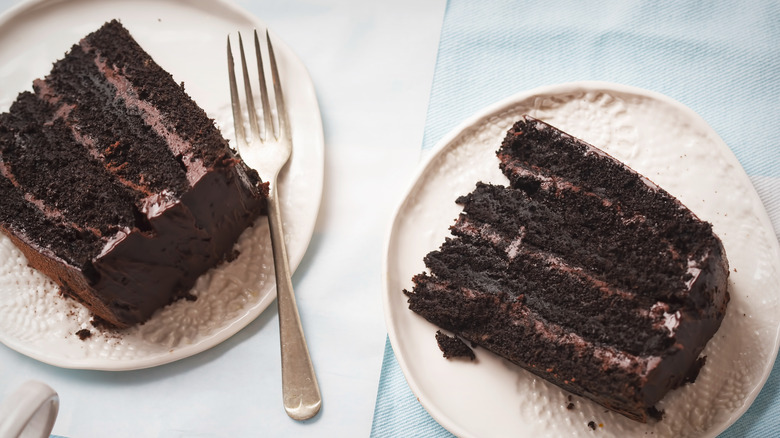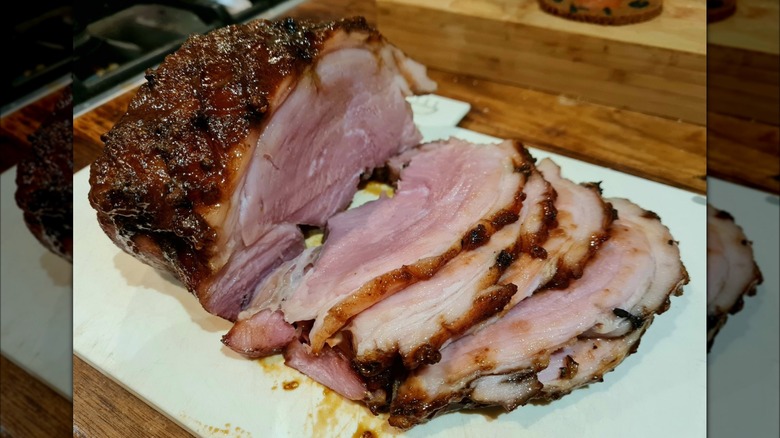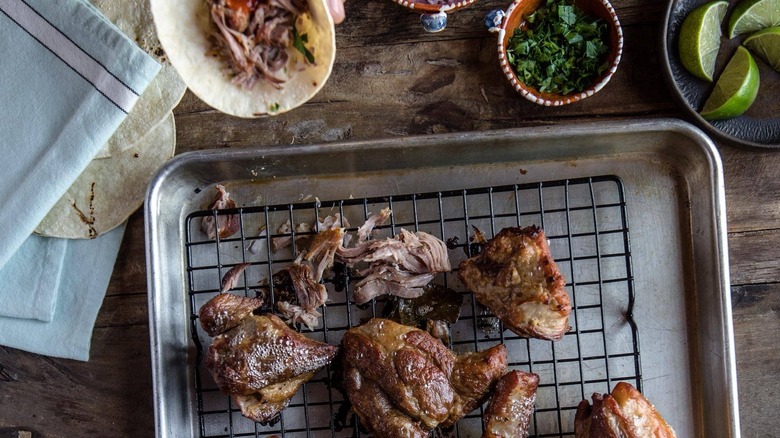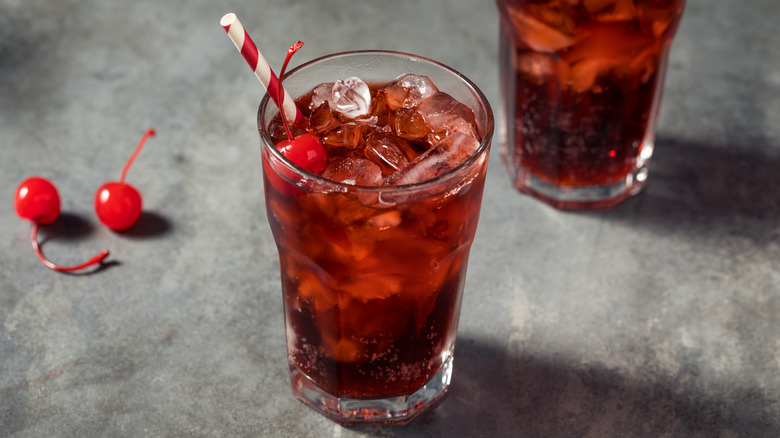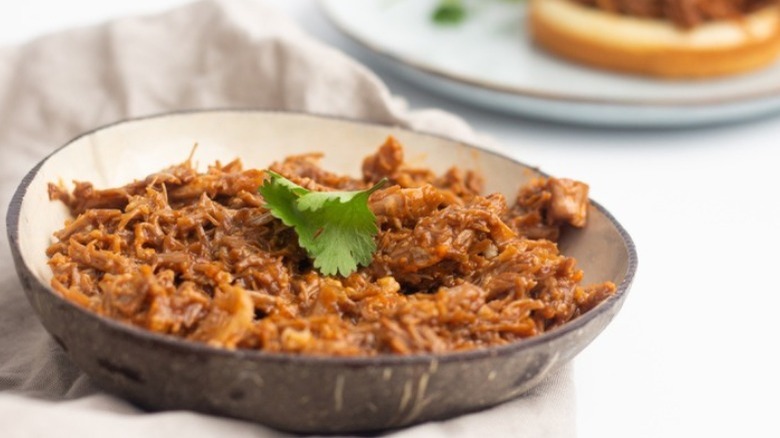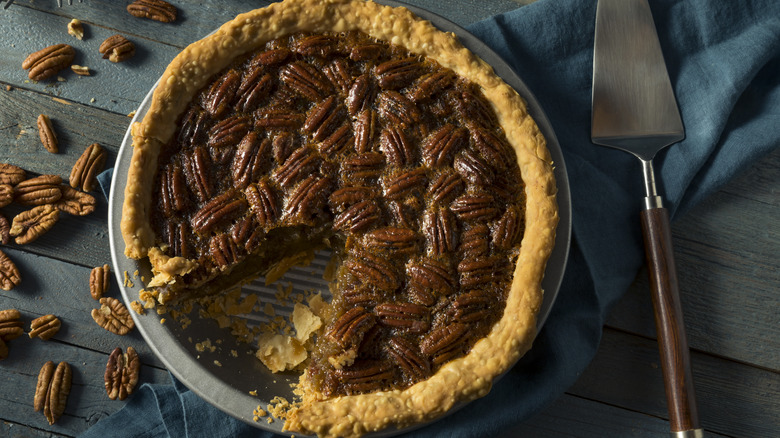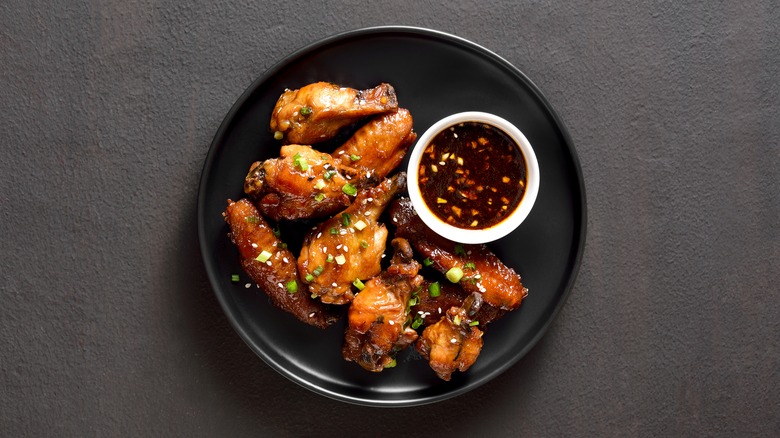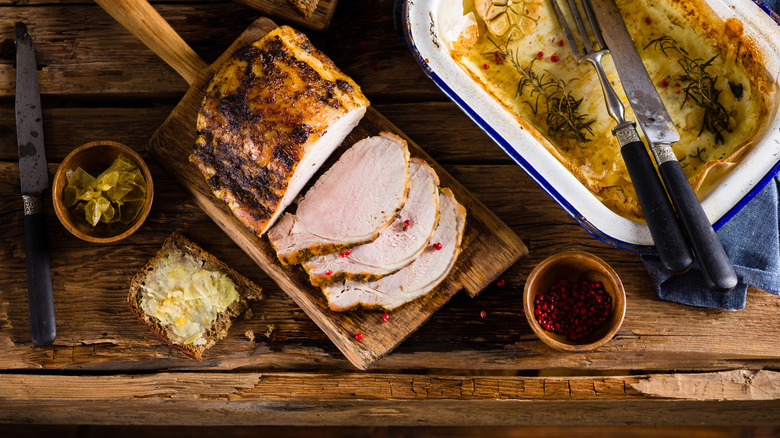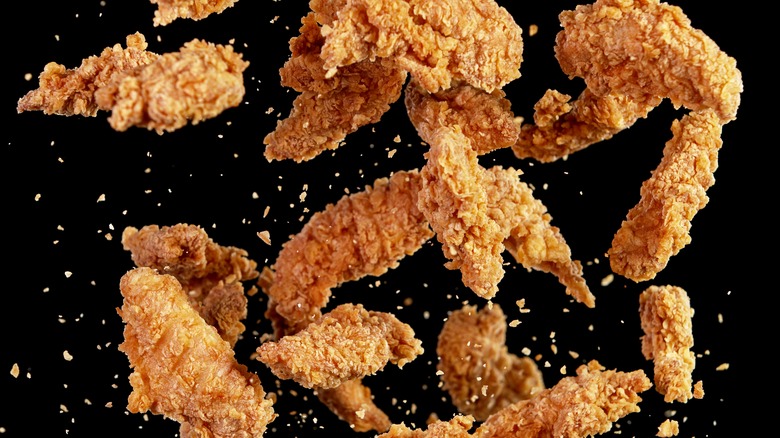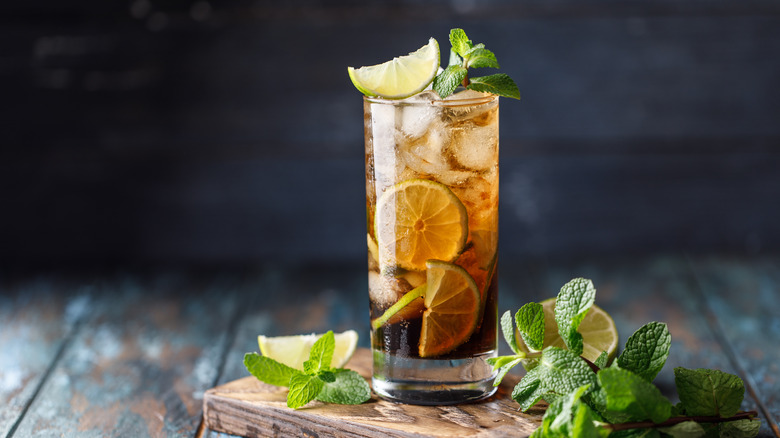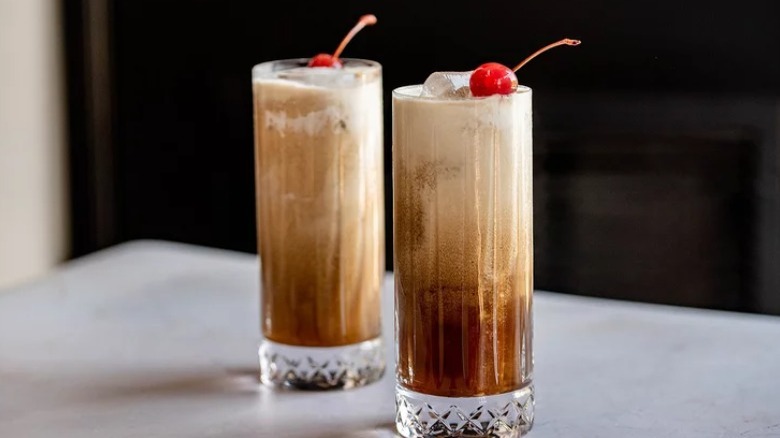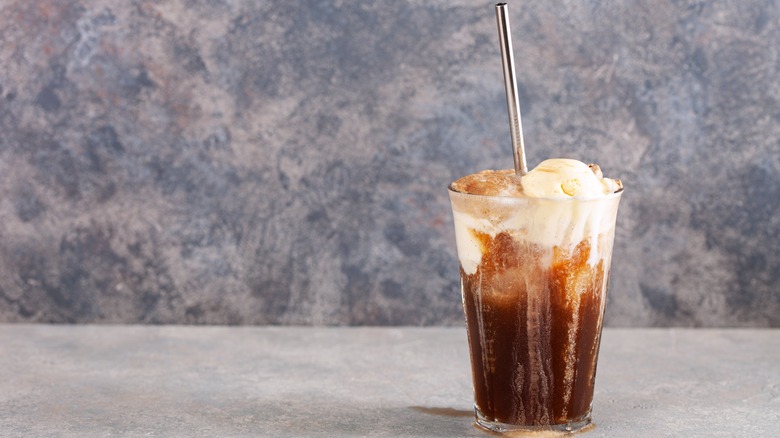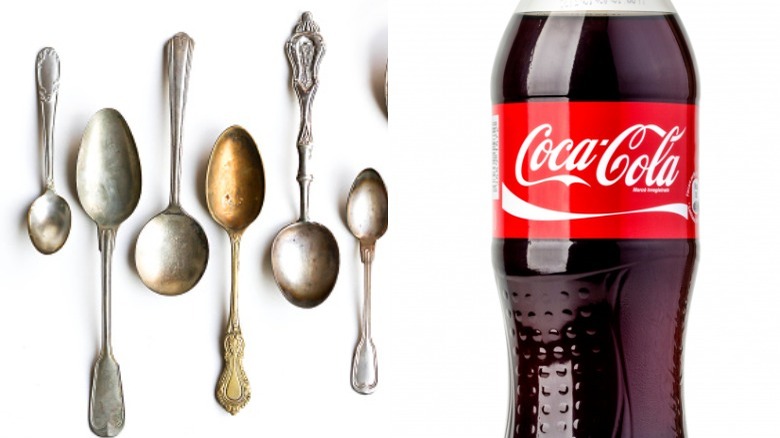The Best Ways To Use Up A Leftover Can Of Coke
If you haven't yet discovered the versatility of using Coca-Cola in everything culinary from food to drinks, it's worthwhile to explore the possibilities the next time you have a leftover can of the stuff.
Coke has been making customers happy since an Atlanta pharmacist first invented it as a tonic in 1886 (via Britannica). Its caramel sweetness, refreshingly strong fizz, and complex flavor profile keep people worldwide buying over 1.9 billion servings of the drink every single day, according to Coca-Cola.
Supposedly, only two people on earth ever know the secret Coke recipe at a time (via This American Life). Despite the secrecy, the flavoring agents are rumored to be lime, vanilla, caramel, orange, lemon, nutmeg, coriander, neroli, and cinnamon, as per TIME. So, as you can imagine, Coke pairs well with many different dishes, from desserts to fried chicken. Nearly any food that tastes good with a Coke as a side drink also tastes good when it's been cooked with Coke. For instance, if you like Coke served with tacos, why not make carnitas with Coke? And for caramel-based goodness in your next batch of chicken wings, try braising them in the same drink. But that's only the tip of the Coca-Cola iceberg. If you've got some leftover Coke hanging around, don't toss it out. Here are some of the best ways to put it to use in the kitchen and beyond.
Replace the wet ingredients in cake mix with cola
Not only is the south the birthplace of Coca-Cola, but it's also the birthplace of soda cakes, made with all manner of soft drinks from Coke to 7UP. Soda cakes likely came about in response to several factors that included a lack of ingredients during wartime rationing, teetotalers who wanted to replace alcoholic ingredients or people who saw a soda cake recipe on the back of a box of cake mix (via Southern Living).
According to many bakers, Coke adds a richer, sweeter flavor and provides extra leavening to help make cakes lighter. When the cola mixes with the baking soda in the cake mix, it creates additional carbon dioxide bubbles, which provide extra leavening and can make the cake extra soft (via Southern Kitchen). However, it's important to note that the carbon dioxide bubbles will dissipate as the Coke's temperature rises. So, it's best deployed by adding the cola when it's very cold and within 15 minutes of opening the can or bottle (via Chicago Tribune).
Using cola in a cake is especially handy if you find yourself missing ingredients and don't want to run to the grocery store. And, as food shortages continue, you may be pleased to learn that you can continue to make a cake with nothing but 12 ounces of leftover Coke and a box of cake mix. If you're out of oil or eggs, a little bit of ingenuity and Coca-Cola makes cake still possible.
Create a cola glaze for ham
The secret to a great ham nearly always includes an excellent glaze. It not only adds a glossy visual facet to your ham, but the right glaze can make your ham utterly delicious and crave-worthy. While some people like a more savory glaze, we think the best ones have a caramel sweetness to them. Thus, Coke's caramel flavor makes it a surprising yet excellent addition to your next ham glaze.
Part of cooking the perfect ham involves a glaze that should create a beautiful, glossy exterior as the sugar in the mix caramelizes. Usually, you shouldn't add glaze to a ham until the last 15 to 20 minutes of cooking, according to Better Homes & Gardens. However, the most basic Coke-glazed ham is a lower-maintenance affair than usual.
According to Kathy's Southern Kitchen, you can simply pour the cola marinade over the meat, cover it with foil, and cook until done. All you have to do is remove the foil to allow it to brown during the final 20 minutes or so of cooking. She adds a cup of brown sugar and a tablespoon of Dijon mustard to a 12-ounce can of Coke for her glaze. However, the ingredients you pair with Coke in your glaze are entirely up to you, allowing for plenty of experimentation with your next Coke ham glaze.
Add it to carnitas
There are several ways to make the Mexican pork dish carnitas. These "little meats" are essentially pulled pork that's been cooked in spices and a flavorful liquid. Broadly speaking, it doesn't matter what part of the pig you use, and there's no one way that Mexican cooks make or eat carnitas. While visiting family in Mexico, chef Jet Tila discovered that the secret to his family's flavorful and visually-pleasing carnitas was Mexican Coke (via Twitter).
Many people closely guard their secrets when it comes to exactly what goes in their carnitas, as per El Pollo Norteño. The most basic form of carnitas simply cooks in lard to produce meat that is moist inside and crisp on the outside (via Dots on a Map). However, if want to try making a carnitas recipe that includes Mexican Coke, you can also try pairing it with other acidic liquids like orange and lime juice. Mexican Coke isn't essential to Coke carnitas, but we think it tastes better since it's made with real sugar instead of less-healthy high fructose corn syrup.
Use it to make a Roy Rogers mocktail
Roy Rogers was a famous cowboy actor and singer who enjoyed his greatest period of popularity from the 1930s to the 1950s (via Britannica). The drink, intended for kids to have a special party drink that didn't include alcohol, typically consists of Coke, grenadine, and maraschino cherries. Some Roy Rogers drinks also include lemon wedges for a bit of an acidic edge (via Delighted Cooking). So, if you have some leftover Coke, why not turn it into a delightful Roy Rogers mocktail?
The Roy Rogers is not too different from the widely enjoyed Shirley Temple mocktail. The main difference is that the Roy Rogers mocktail uses Coke, while a Shirley Temple uses ginger ale or another non-cola soft drink, as well as lime juice. Delighted Cooking reveals that other names for the Roy Rogers drink include the Shirley Temple Black, Grenadini, or Darth Vader. With fewer generations now familiar with the cowboy Roy Rogers, it's not surprising that the drink has often been rebranded with a more-familiar name.
Use it as the secret ingredient in pulled pork
Pulled pork is one of the most beloved meats people use for barbecue in the United States. According to Bearded Butchers, this cut of meat is often called "picnic roast" if it comes from the pig's leg or "Boston butt" if it comes from the pig's shoulder. That last name may not sound intuitive, but it makes more sense when you learn butchers used to pack the cheap pig shoulders in barrels called "butts," and so the name stuck.
Many regions in the U.S. have their style of barbecue sauce to be used with pulled pork along with other meats. Moreover, barbecue sauce recipes tend to vary from cook to cook. If you're looking to craft your own, one easy way to make sweet barbecue sauce is to use leftover Coke, along with paprika, onion powder, garlic powder, chili powder, and salt. If you smoke your meat, it's more common to add the barbecue to the pork on the plate. However, if you choose another type of cooking method for your BBQ pulled pork, such as in the Instant Pot, you can add some of this Coke-infused sauce to the meat as it cooks and save the rest for once it's done.
Use it in a pecan pie
The humble pecan pie owes its popularity to the wife of a corporate sales executive. As per Slate, she reportedly invented the modern version of this in the 1930s to help promote Karo corn syrup. The original Karo recipe for pecan pie called for a mixture of pecans, eggs, vanilla, sugar, and Karo corn syrup to be baked in a pie shell. Karo used the recipe for pecan pie in its ad campaigns in a big way from then on, helping to keep pecan pie popular for decades.
Fast forward to the 2020s, when Coca-Cola decided to get into the pecan pie business by publishing a recipe for Coca-Cola pecan pie on the back of a Coke-branded Christmas card. In addition to the normal ingredients for pecan pie, the recipe calls for melted butter and Coke. With sweetness coming from Coke, sugar, and corn syrup, this takes an already sweet pie to the next level. Tammy Nichols from Collard Valley Cooks adds a little flour to keep it from being runny, in an attempt to counteract all the wet ingredients in the pie (via YouTube).
Make cola-braised chicken wings
Southern Kitchen says that Coke is an excellent ingredient for a liquid-based cooking method like braising. Next time you're using this technique on chicken wings, consider swapping out Coke for some of the liquids in the original recipe. Furthermore, if you allow the Coke to reduce at the end of the cooking time, you'll end up with a thick, intensely-flavored, molasses-like sauce. This sauce lends itself well to Asian-inspired chicken wing flavors like sweet ginger garlic wings.
This thick, caramelized sauce makes the perfect glaze for chicken wings, especially with additions of aromatic ingredients like garlic and ginger, as well as flavorful liquids like rice vinegar or sherry. Bear Cuisine adds Coke, soy sauce, garlic, and ginger to their Coke-braised chicken wings (via YouTube). You can also try adding pepper flakes or hot sauce to raise the heat.
You'll have to keep a careful eye on the proceedings, however. Southern Kitchen says that the trick to braising chicken wings with Coke is to keep a watch on the glaze toward the end of the braising period to ensure that it doesn't burn.
Add Coca-Cola to your meat marinade
If you look at the ingredient list on a can of Coca-Cola, you will find that it contains phosphoric acid. Phosphoric acid provides the tangy flavor that is key to the Coke experience (via Healthline). That also makes it well-suited to marinades. Exploratorium explains that tougher pieces of meat contain more collagen, which is tough to break down. According to MasterClass, marinating meat in acid — like the phosphoric acid in Coke — breaks down the meat's tough fibers to help tenderize even the cheapest, toughest cuts.
For the best effect, allow the meat to sit in a Coke-based marinade for 30 minutes to an hour. Keep in mind that, because you are soaking your meat in acid, there's an upper limit of eight hours for the marination process (via Southern Kitchen). This means that a Coke-based marinade is not suitable for an overnight or all-day soak, less the meat falls to unpleasant bits.
Chef Adam Richman says that he, his mom, and his grandmother all use soft drinks like Coke as a marinade when cooking tougher pieces of meat. He always puts his meat down on a bed of onions before dousing it in a mixture of Coke (or root beer), Guinness, oyster sauce, salt, pepper, and garlic (via TODAY).
Use it to make crispy fried chicken
James Beard award-winning chef John Currence explains that southern chefs take their fried chicken-cooking abilities very seriously. Over a decade ago, he thought of using the same Coke he liked to eat with his chicken as the base for his fried chicken bine. After a bit of experimenting, he's not shy about proclaiming it to be a superior method of flavoring and cooking fried chicken. If you don't want to take our or Currence's word for it, Coca-Cola fried chicken is so over-the-top good that Coca-Cola itself featured Currence's recipe on its YouTube.
One thing that a cola brine does for fried chicken is to give it a sweet flavor. Plus, the phosphoric acid in the Coke helps to make the chicken more moist and tender than usual. Currence's chicken brine contains cola to tenderize and sweeten the meat over a few hours of marinating, though the batter does not. So, next time you have some leftover Coke and a hankering for fried chicken, try brining your chicken in Coke for a couple of hours before you fry it up.
Spike it for a Long Island iced tea
If you don't plan to go anywhere anytime soon, why not turn your leftover Coke into a Long Island iced tea? Just add vodka, gin, rum, tequila, and triple sec (or Cointreau) to your Coke, along with lemon juice and ice. With five types of alcohol, Long Island iced tea typically contains around 22% alcohol by volume, which can pack quite a punch (via Culture Trip). With such a strong reputation, you'll want to proceed with caution and stay hydrated, lest you peel yourself off the floor the next morning with a mondo headache.
If you're going to be combining that many types of alcohol with your Coke, it's tempting to go out and buy the cheapest varieties available at the liquor store. Unfortunately, that's where many people make their greatest mistake with Long Island iced tea. The hangover headache you associate with this cocktail is nearly always because bartenders use cheaper booze. The cheaper your alcohols, the more likely they are to have impurities because they haven't been distilled as often as more expensive alcohols. Your body processes these impurities like poison, which can often lead to headaches, especially if your body isn't very good at metabolizing them (via Gizmodo).
Turn it into a Colorado bulldog cocktail
If you like Cherry Coke and creamy coffee-based alcoholic drinks like White Russians, then you're going to love the Colorado Bulldog cocktail. When it comes to making this drink, you start by crafting a White Russian with heavy whipping cream, your favorite vodka, and Kahlua coffee liqueur. For the Colorado Bulldog variation, you then add Coke and maraschino cherries. You could also use Cherry Coke or another variety, such as Vanilla Coke. The resulting drink is reminiscent of a Coke float with a coffee taste thanks to the Kahlua. Once you have your first Colorado Bulldog, you may never want to go back to a plain White Russian again.
If you don't have heavy cream or are lactose intolerant, use any other sort of creamy drink instead of the heavy whipping cream. Try a lighter dairy option like half-and-half or even whole milk. If you need a non-dairy substitute, reach for something like rice or oat milk — just search for the creamy variety, if possible. But think twice before adding a liquid creamer unless the flavor complements Coke and cherries, as you have less control over the flavor ratios.
Make it into a Coke float
If you've got leftover Coke and some ice cream in your freezer, you win the What Can I Do With My Leftover Coke game. There's just something special about the combination of ice cream with Coke that makes for an extra-happy day. As the story goes, soda fountain proprietor Robert McCay Green dreamed up the first ice cream float in Philadelphia in 1874. One version maintains that he added ice cream to plain soda when he ran out of sweet cream, as per "Sundae Best: A History of Soda Fountains."
The most basic Coke float consists of simply two ingredients: vanilla ice cream and Coke. But there's no need to stop there. Flavored Cokes like Cherry Coke and Vanilla Coke certainly make a tasty twist on a classic. While you're at it, why not try a Coke float with some other ice cream flavor from your freezer like raspberry cheesecake or strawberry?
For a more adult drink, turn your Coke float into a cocktail. The Morning Advertiser says that Hillhead Book Club in Glasgow, Scotland, adds vanilla vodka and orange liqueur to its Coke Float, which makes sense since vanilla and orange are rumored to be among the flavoring ingredients in Coke (via TIME). You could also add other flavored liqueurs like amaretto, Kahlua, or Godiva chocolate liqueur.
Use it for cleaning
When you have leftover Coke, you don't necessarily have to use it as an ingredient in a food or drink. Why not use it for cleaning? If you have anything metal that could use some sprucing, you can place it in a Coke bath overnight. With the right materials, you could wake up to a shinier, cleaner coin, a bit of jewelry, or a piece of silverware. CNET says you can also use Coca-Cola to clean an oil stain from concrete or to remove smashed bugs from your windshield. Some people even claim you can clean your toilet with Coke (via TODAY).
How is this possible? Chemistry Cachet says that the main cleaning power of Coke comes from its phosphoric acid and citric acid, which can help to cut through hard water stains and rust if you leave it to soak. While Coca-Cola doesn't deny the cleaning power of its drink, it nevertheless suggests that you may be better off with more standard cleaning products. It does, after all, contain sugar or corn syrup that could produce a sticky mess.
There's a rumor that the phosphoric acid in cola is strong enough to dissolve a nail in only a few days. However, when As Seen on Social Media put the rumor to the test, it turned out that the nail was still intact with only slight oxidation a little over a year into its Coca-Cla soak (via YouTube). So, while Coke is certainly acidic, it's not that acidic.
